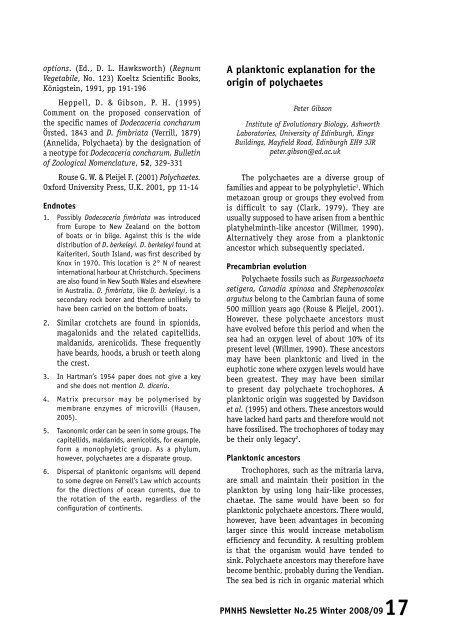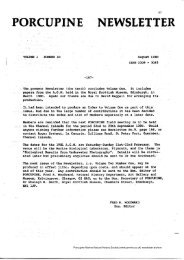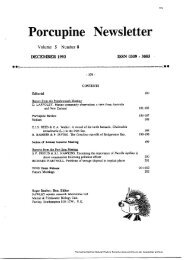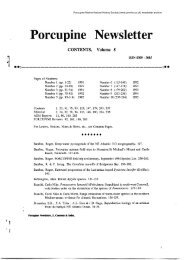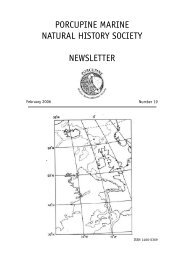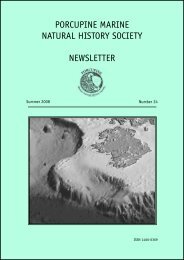Porcupine Newsletter Number 25, Winter 2008/09.
Porcupine Newsletter Number 25, Winter 2008/09.
Porcupine Newsletter Number 25, Winter 2008/09.
You also want an ePaper? Increase the reach of your titles
YUMPU automatically turns print PDFs into web optimized ePapers that Google loves.
options. (Ed., D. L. Hawksworth) (RegnumVegetabile, No. 123) Koeltz Scientific Books,Königstein, 1991, pp 191-196Heppell, D. & Gibson, P. H. (1995)Comment on the proposed conservation ofthe specific names of Dodecaceria concharumÖrsted, 1843 and D. fimbriata (Verrill, 1879)(Annelida, Polychaeta) by the designation ofa neotype for Dodecaceria concharum. Bulletinof Zoological Nomenclature, 52, 329-331Rouse G. W. & Pleijel F. (2001) Polychaetes.Oxford University Press, U.K. 2001, pp 11-14Endnotes1. Possibly Dodecaceria fimbriata was introducedfrom Europe to New Zealand on the bottomof boats or in bilge. Against this is the widedistribution of D. berkeleyi. D. berkeleyi found atKaiteriteri, South Island, was first described byKnox in 1970. This location is 2° N of nearestinternational harbour at Christchurch. Specimensare also found in New South Wales and elsewherein Australia. D. fimbriata, like D. berkeleyi, is asecondary rock borer and therefore unlikely tohave been carried on the bottom of boats.2.3.4.5.6.Similar crotchets are found in spionids,magalonids and the related capitellids,maldanids, arenicolids. These frequentlyhave beards, hoods, a brush or teeth alongthe crest.In Hartman’s 1954 paper does not give a keyand she does not mention D. diceria.Matrix precursor may be polymerised bymembrane enzymes of microvilli (Hausen,2005).Taxonomic order can be seen in some groups. Thecapitellids, maldanids, arenicolids, for example,form a monophyletic group. As a phylum,however, polychaetes are a disparate group.Dispersal of planktonic organisms will dependto some degree on Ferrell’s Law which accountsfor the directions of ocean currents, due tothe rotation of the earth, regardless of theconfiguration of continents.A planktonic explanation for theorigin of polychaetesPeter GibsonInstitute of Evolutionary Biology, AshworthLaboratories, University of Edinburgh, KingsBuildings, Mayfield Road, Edinburgh EH9 3JRpeter.gibson@ed.ac.ukThe polychaetes are a diverse group offamilies and appear to be polyphyletic 1 . Whichmetazoan group or groups they evolved fromis difficult to say (Clark, 1979). They areusually supposed to have arisen from a benthicplatyhelminth-like ancestor (Willmer, 1990).Alternatively they arose from a planktonicancestor which subsequently speciated.Precambrian evolutionPolychaete fossils such as Burgessochaetasetigera, Canadia spinosa and Stephenoscolexargutus belong to the Cambrian fauna of some500 million years ago (Rouse & Pleijel, 2001).However, these polychaete ancestors musthave evolved before this period and when thesea had an oxygen level of about 10% of itspresent level (Willmer, 1990). These ancestorsmay have been planktonic and lived in theeuphotic zone where oxygen levels would havebeen greatest. They may have been similarto present day polychaete trochophores. Aplanktonic origin was suggested by Davidsonet al. (1995) and others. These ancestors wouldhave lacked hard parts and therefore would nothave fossilised. The trochophores of today maybe their only legacy 2 .Planktonic ancestorsTrochophores, such as the mitraria larva,are small and maintain their position in theplankton by using long hair-like processes,chaetae. The same would have been so forplanktonic polychaete ancestors. There would,however, have been advantages in becominglarger since this would increase metabolismefficiency and fecundity. A resulting problemis that the organism would have tended tosink. Polychaete ancestors may therefore havebecome benthic, probably during the Vendian.The sea bed is rich in organic material whichPMNHS <strong>Newsletter</strong> No.<strong>25</strong> <strong>Winter</strong> <strong>2008</strong>/0917


